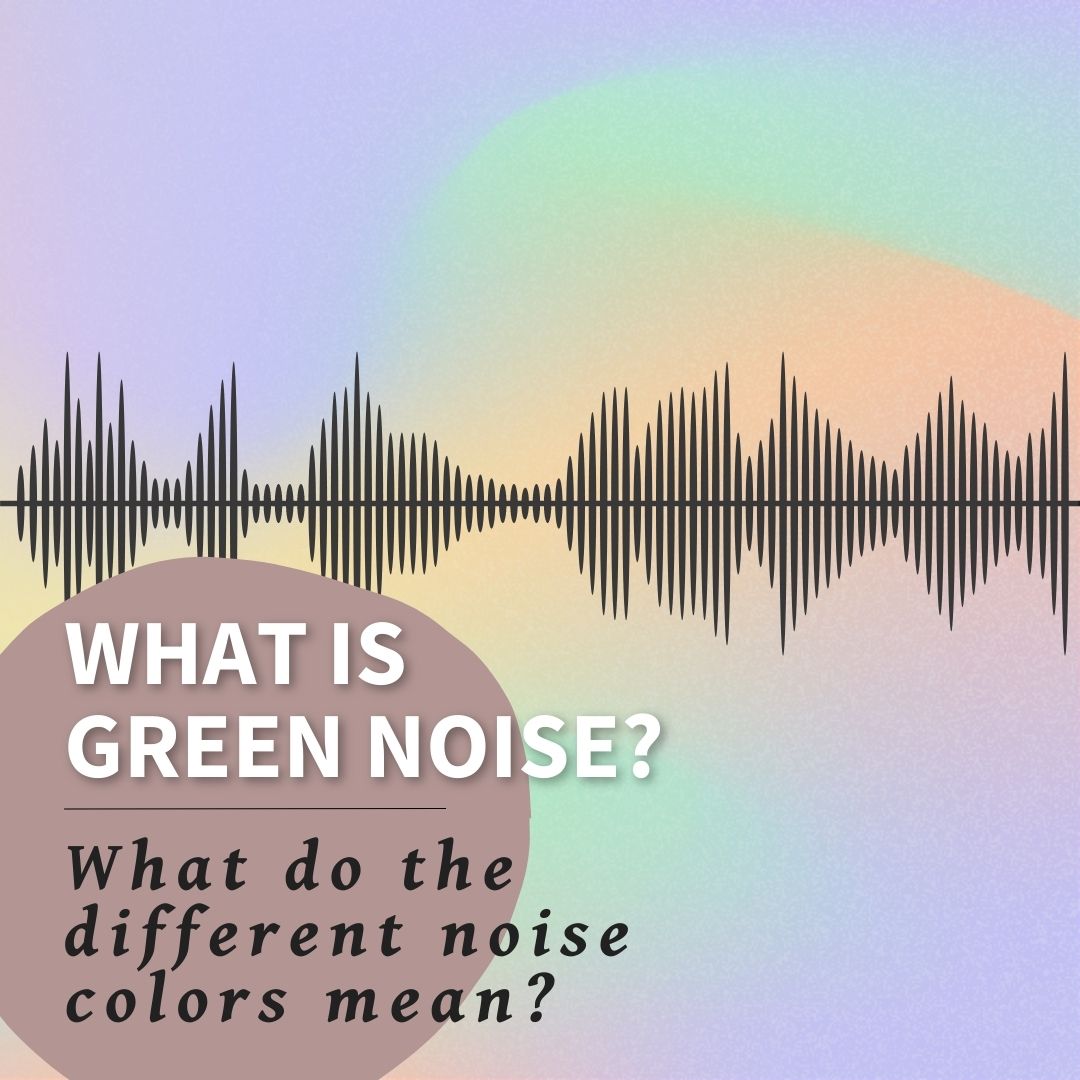What is Green Noise?
Green noise is a subset of white noise that contains an equal amount of energy per frequency octave. This type of noise is similar to white noise but has a more natural sound because it has more energy in the lower frequencies. Green noise is specifically designed to be calming and soothing. It resembles the sound of falling rain, waterfalls or rustling leaves.
Green noise is often used in sound therapy, which uses sound to help people relax and focus. It can be used to reduce stress, anxiety, and depression. Like white noise, it is also used to help reduce the effects of tinnitus.
In meditation, Green Noise can help people focus on their breathing and clear their minds. This helps people relax and enter a meditative state.
Green noise is also used as a sleep aid. It can help people fall asleep faster and stay asleep longer. It can also help reduce the effects of insomnia.
Green noise can also be used to mask other sounds. It can be used to block out traffic noise, a neighbor’s television, or other distracting sounds. This can help people focus on their work or studies.
Other Noise Colors
Besides green noise, there are several other colors of noise. Each noise color has a unique energy distribution. The most common types of noise include:
What is White Noise?
This type of sound has the same amount of energy across all frequencies. It is often used for masking or canceling out other background noises.
White noise can also be soothing and can help to create a calming atmosphere, often being used as a sleep aid. It also helps increase concentration and focus in environments that may be filled with distracting noises. White noise is generally created with electronic devices. It can also occur naturally in nature, such as waves crashing against the shore, wind blowing through trees, or a crackling fire.
What is Pink Noise?
This color noise has become increasingly popular in recent years. It is characterized by its unique frequency distribution, which is why it is sometimes referred to as “1/f noise.”
Unlike other types of noise, pink noise has more energy in the lower frequencies. This makes it especially helpful for creating a more relaxing environment.
Pink noise is used in many applications such as audio production, sound engineering and meditation. Pink noise is commonly used for sleep aid.
What is Brown/Red Noise?
Brown noise (also called Red noise) is similar to pink noise but with even more energy concentrated in the lower frequencies. It has a deep, rumbling sound that is commonly used for masking or blocking out other sounds. It’s often used in sound therapy and soundscapes to help reduce stress, improve sleep, and create a calming atmosphere.
Brown noise has been found to be particularly helpful in drowning out distracting noises like snoring or traffic. Many people find it to be a soothing, calming sound that helps them relax and get a better night’s sleep. In addition, brown noise has been used by musicians to enhance the bass frequencies of their recordings. In audio mastering it has a powerful low-end impact.
What is Blue noise?
Blue/azure/cobalt noise as a specific frequency distribution with more energy in the higher frequencies than in the lower frequencies. It is essentially ‘brighter’ than other types of noise. This makes blue noise great for applications such as audio processing. It can help to mask out lower frequency sounds and create a more balanced soundscape.
Blue noise is also useful for tasks like image processing surprisingly. It can help to reduce unwanted artifacts and improve the overall quality of the image.
What is Violet Noise?
Violet/purple noise has even more energy in the higher frequencies than blue noise. It is characterized by a power spectrum that falls off inversely with frequency. This means that as frequency increases, the power of the signal decreases.
Violet noise is typically used in audio applications such as sound synthesis and audio engineering. It can be used to create unique sound effects and to shape the frequency spectrum of a sound wave.
Many consider violet noise to be more “musical” than other types of noise. Its higher frequencies create a more pleasing sound to the human ear.
Uses and Effects of Noise Colors
Noise can have both positive and negative effects on the body and mind. Here are some of the effects that different types of noise can have:
- Improved Sleep – White noise and pink noise can improve sleep quality by masking background noises and promoting relaxation.
- Increased Focus – Brown noise can improve focus and concentration by reducing distractions and promoting calmness.
- Tinnitus Relief – Some types of noise, such as white noise, can help reduce the symptoms of tinnitus by masking the ringing or buzzing sounds.
- Stress Relief – Green noise and other types of nature sounds can promote relaxation and reduce stress.
- Meditation – Brown noise and other relaxing sounds can be used for meditation and mindfulness practices.
- Productivity – Some people use noise to increase productivity by blocking out distracting sounds and promoting focus.
Noise Color FAQs
Q: What is the difference between green noise and white noise?
A: Green noise has more energy in the lower frequencies than white noise, which makes it a more natural sound. For some people Green noise is more pleasant but that varies person to person.
If you are going to start testing out noises in your life we recommend seeing a licensed sound therapist. If that is not an option, trying them out and reflecting on the different colored noises effects on you is a good way to find what works best for your use case.
Q: Can noise really improve sleep quality?
A: The short answer: Yes, noise can improve sleep quality. Using your preferred noise can mask background noises and promote relaxation. White noise and pink noise are the most common types of noise used for this purpose.
The longer answer is: It depends. Using a background noise for sleep can impact our body’s ability to sleep naturally. This is just fine if you use your phone as your sound machine because you have it with you all the time. If you use a different sound machine and become dependent on it, sleeping while away from it can prove difficult.
Experts recommend using sleep noises to help you relax but turning them off before falling asleep as often as possible. This allows your body to naturally drift off to sleep without the sounds if needed.
Q: How can I use noise to increase productivity?
A: You can use noise to increase productivity by blocking out distracting sounds and promoting focus. Brown noise and other relaxing sounds are often used for this purpose.
The lack of lyrics or a beat allows your mind to truly focus on the task at hand. You avoid being distracted by your surroundings or other elements present in the audio like you might be if listening to a song of some sort.
Q: Which is better for sleep, pink noise or white noise?
A: One of the reasons pink noise is thought to be effective is that it has a more balanced spectrum of frequencies compared to white noise. White noise contains equal energy across all frequencies. At times this can be too harsh for some people and cause discomfort or even stress. Pink noise, on the other hand, has more energy in the lower frequencies. This can be soothing and promote relaxation.
Research has shown that pink noise can improve the quality of deep sleep, which is the most restorative stage of sleep. One study found that playing pink noise during sleep helped participants achieve a deeper stage of sleep. This improved memory consolidation and cognitive performance. In contrast, white noise did not have the same effect and may even disrupt sleep in some individuals.
However, it’s worth noting that the effects of noise on sleep can vary from person to person. There is no one-size-fits-all solution. Some people may find that white noise works better for them.
The volume and type of noise can also make a difference. Very loud or sudden noises can be disruptive to sleep regardless of their color.
Q: Which is better for sleep, green noise or pink noise?
A: Limited research on the impact of green noise on sleep makes it unclear how green noise impacts sleep compared to pink noise or other types of noise.
Green noise has a power spectral density between white and pink noise. This means that it has more energy at mid-range frequencies compared to white noise, but less energy at higher frequencies compared to pink noise.
As mentioned above, pink noise has been found to improve the quality of deep sleep. It has more energy in the lower frequencies that can be soothing and promote relaxation.
It is possible that green noise may have a similar effect, as it has some overlap with the frequency range of pink noise. It is also possible that the different spectral characteristics of green noise may have a different impact on sleep quality compared to pink noise.
Ultimately, more research is needed to understand the effects of different colors of noise on sleep, and to determine how green noise specifically may differ from other types of noise in its impact on sleep quality.

